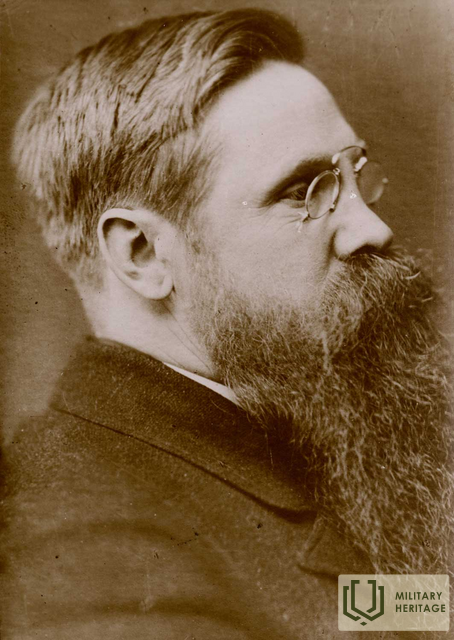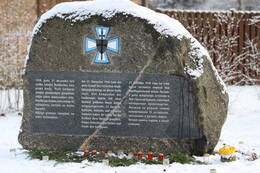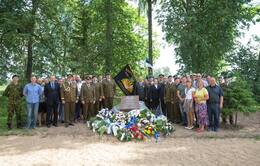Andrievso Niedros vyriausybė
I WW1, I Nepriklausomybės karai
Rido vyriausybė buvo provokiška Latvijos laikinoji vyriausybė, gyvavusi nuo 1919 m. gegužės 10 d. iki birželio 26 d., kartu su nuversta Kārlio Ulmanio laikinąja vyriausybe ir Pēterio Stučkos LSPR vyriausybe.
Po to, kai balandžio 16 d. perversmo metu buvo nuversta Ulmanio Laikinoji vyriausybė, balandžio 27 d. į Liepoją atvyko Andrievas Niedra kaip tarpininkas derybose su pučistų Borkovskio vyriausybe. Jo prašymu balandžio 29 d. buvo paleisti vokiečių suimti Ulmanio kabineto ministrai. Pagrindinė pučistų ir nuverstos Laikinosios vyriausybės derybų tema buvo naujos kompromisinės vyriausybės, kurioje būtų atstovaujama ir Baltijos vokiečiams, kaip ekonomiškai ir kariškai reikšmingiausiai Latvijos gyventojų daliai, sudarymas. Niedra pasiūlė vokiečiams viešai pasmerkti balandžio 16 d. perversmą, tačiau Liaudies taryba pavedė naujam kandidatui sudaryti vyriausybę, kurioje būtų 4 Ulmanio vyriausybės ministrai, 4 Niedros šalininkų ministrai, 3 vokiečiai ir 1 žydas. Ulmanis šį pasiūlymą atmetė.
Galiausiai gegužės 10 d. buvo suformuotas naujas Ministrų kabinetas, vadovaujamas Andrievso Niedros. Dauguma valstybės tarnautojų toliau vykdė savo tiesiogines pareigas, nepriklausomai nuo Ministrų kabineto sudėties bet kuriuo metu. Naujoji vyriausybė numatė tris pagrindinius savo egzistavimo uždavinius: išsaugoti valstybę, atkurti teisėtvarką ir ekonomiką, išvaryti bolševikus, surengti Steigiamojo Seimo rinkimus ir suformuoti visuotinai renkamą vyriausybę.
Niedros vyriausybė valdžioje buvo iki 1919 m. birželio pabaigos, kai po pralaimėjimo Cėsių mūšyje, birželio 24 d. vykusiame Ministrų kabineto posėdyje buvo nuspręsta kreiptis į Antantės atstovus ir perduoti jiems jų įgaliojimus. Pralaimėję Latvijos nacionalinės gvardijos ir vokiečių samdinių kariuomenės (Geležinės divizijos) daliniai, pagal Strazdmuizoje sudarytą susitarimą, prižiūrimi Antantės šalių, evakavo iš Rygos į Žiemgalą. Po Strazdmuizos paliaubų Niedros kabinetui ištikimų kariuomenės daliniai, perdavę savo įgaliojimus vyriausybei, arba pripažino K. Ulmanio vadovaujamo Ministrų kabineto atkūrimo teisėtumą, arba prisijungė prie vadinamosios Vakarų Rusijos savanorių armijos.
A.Niedra po Bermonto pralaimėjimo emigravo ir 1924 m. grįžo į Latviją, kur buvo apkaltintas išdavyste. A.Niedros, kaip kaltinamojo, byla 1924 m. buvo nagrinėjama dviejuose teismuose – atskirai už 1919 m. balandžio 16 d. perversmą Liepojoje ir atskirai už dalyvavimą Bermonto planuose. Jam buvo skirta laisvės atėmimo bausmė, kuri vėliau buvo pakeista deportacija iš šalies. Niedra persikėlė į Rytų Prūsiją, kur dirbo pastoriumi. 1942 m. grįžo į Rygą, kur mirė.
Daugiau informacijos šaltinių
Vikipedija. Niedros vyriausybė. Prieinama: https://lv.wikipedia.org/wiki/Niedras_vald%C4%ABba [žiūrėta 2021-05-06].
Vikipedija. Andrievs Niedra. Prieinama: https://lv.wikipedia.org/wiki/Andrievs_Niedra [žiūrėta 2021-05-06].
Susijusi laiko juosta
Susijusios vietos
Paminklas pirmajam mūšiui už Latvijos nepriklausomybę
Adresas: Inčukalns, Atmodas g. 2.
2016 m. liepos 3 d. buvo atidengtas paminklas pirmajam mūšiui už Latvijos nepriklausomybę, skirtas Latvijos landesverui (Die Lettländische Landeswehr), kuriame vietos baltų vokiečiai, rusai ir latviai, tuo metu buvę abiejų pusių daliniuose, gynė naujai įkurtą valstybę nuo bolševikų Raudonosios Armijos. Brolių kapų komiteto pirmininkas Eiženas Upmanis tuo metu padarė išvadą, kad tai galėtų būti pirmasis paminklas jungtinėms Latvijos ir Baltijos vokiečių pajėgoms mūšio memorialuose už kapinių ribų. Tuo metu Latvijos landesvero latvių dalinių vadu buvo paskirtas pulkininkas leitenantas Oskaras Kalpaksas, iš kurio dalinių Laisvės kovų metu išaugo ir susiformavo vėlesnė Latvijos armija.
1918 m. visa dabartinės Latvijos teritorija pateko į Vokietijos imperijos ir jos kariuomenės rankas. Tačiau 1918 m. vasaros pabaigoje ir rudenį padėtis ėmė sparčiai keistis prieš Vokietiją ir tapo aišku, kad tik laiko klausimas, kada Vokietija bus priversta pripažinti pralaimėjimą Pirmajame pasauliniame kare. Rusijos imperija, kurios dalimi Latvija buvo iki Pirmojo pasaulinio karo, nustojo egzistuoti anksčiau, po 1917 m. vasario ir spalio revoliucijų. 1918 m. lapkričio 18 d. buvo paskelbta Latvijos Respublika. Vokietijos kariuomenė, kuri po 1918 m. lapkričio 11 d. paliaubų su Antantės valstybėmis buvo dislokuota Latvijos teritorijoje, nebebuvo motyvuota tolesniems karo veiksmams, ir dauguma jos kareivių tiesiog norėjo grįžti į tėvynę.
Tokiomis aplinkybėmis buvo akivaizdu, kad Latvijos gynyba pirmiausia priklausė nuo pačių Latvijos gyventojų suformuotos nacionalinės gvardijos. Iš pradžių, dėl savo išsilavinimo ir santykinai didesnio gebėjimo savarankiškai organizuotis, didžiausią iniciatyvą formuojant tokią nacionalinę gvardiją rodė Latvijoje gyvenantys Baltijos vokiečiai. Į nacionalinę gvardiją įstojo ir Rusijos kareiviai. Siekdama užtikrinti nacionalinės gvardijos aprūpinimą uniformomis, ginklais ir kitais reikalingais ištekliais, Latvijos laikinoji vyriausybė 1918 m. gruodžio 7 d. sudarė susitarimą su Vokietijos atstovu Augustu Vinnigu, numatantį nacionalinės gvardijos aprūpinimą iš Latvijos teritorijoje esančių Vokietijos armijos rezervų. Šiame susitarime, be kita ko, buvo nurodyta, kad ši nacionalinė gvardija, oficialiai vadinama „Latvijas zemessardze“ arba vokiškai „die Lettländische Landeswehr“, bus Latvijos Respublikos ginkluotosios pajėgos.
Latvijos nacionalinė gvardija susidūrė su dviem Latvijos raudonųjų šaulių pulkais (t. y. maždaug 2000–3000 karių), kurie anksčiau buvo patyrę Pirmajame pasauliniame kare ir Rusijos pilietiniame kare. Nepaisant Raudonosios armijos patirties ir skaitinės persvaros, Latvijos nacionalinė gvardija dvi dienas laikė Inčukalną įnirtingose kovose, kol galiausiai 1919 m. sausio 1 d. vakarą, norėdama išvengti apsupties, buvo priversta trauktis, praradusi 43 žuvusius ir kelis sužeistuosius, kurių dauguma buvo bolševikų sučiupti, kur žuvo arba mirė nuo bado ar ligų.
Autorius: Artis Buks. Medžiaga: lauko akmuo. Paminklas pagamintas iš didelio monolitinio akmens, rasto Ruļļuose netoli Jelgavos.
Memorialas Skangalių dvare
Jungtinės Latvijos ir Estijos kariuomenės pergalės mūšyje dėl Skangalių dvaro paminklas yra maždaug už 20 kilometrų nuo Cėsių. Atminimo akmuo, skirtas Cėsių mūšių dalyviams ir Estijos Kalevlaste Malevos bataliono kovotojams, buvo atidengtas 2019 m. birželio 22 d. Jungtinės Latvijos ir Estijos kariuomenės pergalė mūšyje dėl Skangalių dvaro, kuris įvyko čia, buvo lūžio taškas Cėsių mūšiuose, dėl kurio Niedros vyriausybės kariuomenė pradėjo visuotinį atsitraukimą. Andrijevo Niedros vyriausybė buvo laikina provokiška Latvijos vyriausybė, egzistavusi nuo 1919 m. gegužės 10 d. iki birželio 26 d. Puolimas prieš Landesvero dalinį prasidėjo 1919 m. birželio 22 d. ankstų rytą, kai 3-ioji Kalev kuopa, panaudojusi šarvuotį, įsiveržė į Skangalių dvarą ir užgrobė 2 patrankas, tačiau priešas vis tiek perėjo į kontrataką. Šiek tiek vėliau, vidury dienos, kariuomenė pakartojo ataką, ir po įnirtingos artimos kovos Landesvero dalinys buvo išstumtas iš Skangalių dvaro. Tarp mūšio trofėjų – kulkosvaidžiai, didelis kiekis šaudmenų ir kitos kovinės įrangos. Po dviejų valandų estai užėmė svarbią kelių sankryžą prie „Starti“ užeigos. Mūšyje užimant Skangalių dvarą buvo sužeisti arba žuvo 58 „Kalev“ kareiviai. Estija suteikė didelę paramą įrengiant memorialinę vietą.
Susijusi istorija
Iš Ádolfo Erso knygos „Vidzemė kovoje už laisvę“ apie pabėgėlių kelionę Valkoje
Nuo pabėgėlių laikų Valkai buvo skiriamas svarbesnis vaidmuo nei kitiems Vidžemės miestams, nes čia buvo leidžiamas politiškai aktyvus laikraštis „Līdums“, kuriame buvo kaldinami Latvijos dvasiniai ir politiniai ginklai, taip pat todėl, kad tai buvo kryžkelė, kurioje susitiko keliai iš trijų Latvijos pusių: iš Rygos, Alūksnės, Mozekilės, taip pat iš Estijos ir Rusijos. Ji turėjo ryšių su pabėgėliais iš visų pusių – Tartu, Pliskos, Maskvos ir Sankt Peterburgo. Čia buvo didelis pabėgėlių centras.








